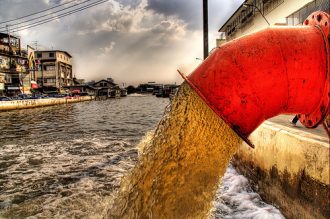Contributing writer for Wake Up World
What happens when we flush the toilet is not normally high on the list of dinner table topics, but a few forward thinking individuals are taking the subject seriously. Since water security, ecology and health are all top concerns facing us today, technology that addresses our wasteful bathroom and household practices is nothing to be scorned. In fact, our poo and pee can be environmental champions, if given half a chance.
A New Take on Sewage
“Think of your poo and pee as a health smoothie for a tree.” ~ Molly Winter in “The Taboo Secret to Better Health”
When indoor plumping was invented, it was viewed as a hallmark of advanced civilization. But there’s a dark side to modern plumbing that we rarely consider. Beyond the sheer volume of water used to flush a toilet, take a shower or run a load of laundry, we also significantly pollute our natural waterways.
One example is prescription meds. Since only about half of all pharmaceutical drugs are filtered by traditional sewage treatment plants, an alarming number are showing up in our rivers, streams and oceans — to the point where salmon swimming in contaminated water are testing positive for a range of prescription meds, as well as street drugs. It’s not just salmon being affected, the entire eco-system is at risk. And humans aren’t immune from the problem either. Seven million people get sick annually from drinking sewage contaminated water here in the U.S. — and 900 die.
So why is sewage being dumped into waterways to begin with? In short, because sewage and rainwater are directed to the same treatment plant — and when the facility is overwhelmed with a big storm, dumping raw or partially treated sewage into waterways is standard practice.
But Molly Winter, director of Recode, a nonprofit dedicated to advancing sustainable building and development practices, believes there’s a better way.
“I think you’re ready for it. I think we as a culture are ready for advanced potty training. And there are three great reasons to enroll today. Number one: we can fertilize our food. Each one of us is pooping and peeing something that could fertilize half or maybe all of our food, depending on our diet. That dark brown poo in the toilet is dark brown because of what? Dead stuff, bacteria. That’s carbon. And carbon, if we’re getting that into the soil, is going to bind to the other minerals and nutrients in there. Boom! Healthier food. Voilà! Healthier people. Chemical fertilizers by definition don’t have carbon in them. Imagine if we could move our animal manure and our human manure to our soil, we might not need to rely on fossil fuel-based fertilizers [or] mine minerals from far away. Imagine how much energy we could save,” she says.
If we alter our approach to sanitation, we can dramatically slowdown the effects of carbon-based pollution as the carbon in poop, when integrated back into the soil, will absorb carbon dioxide we pump into the air. Since living ecosystems rely on the cycle of food and poop for nourishment, this process could be a valuable way to help re-balance our relationship with our natural world and even mitigate some of the environmental damage human systems have caused.
And some are already taking the idea of tapping into the power behind wastewater and running with it…
Leading The Way
In New Mexico, a group of people had the courage to look at what is going down the toilet as a resource, and created a unique waste treatment plant right in the center of their community. It looks like a park, a beautiful natural space. But it’s also serving an important purpose. There’s poo at the bottom layer of the gravel — completely contained and not contaminating anything — which feeds the surrounding marsh plants. The wastewater is thoroughly purified through the natural filtration process, where crystal clear, clean water comes out the other end and travels underground to water everyone’s yard. The community is in the desert, and yet they have their own special oasis.
Single family homes and high-rise residential buildings are also integrating closed-loop wastewater systems. One example is a house in Portland, Oregon, that has a composting toilet, which, overtime, turns all their pee and poo into a rich soil amendment. Their wash and shower water is funneled to an underground series of mulch basins that purify it, and then send it downhill to water the orchard.
Additionally, three apartment buildings in the same city don’t flush anything into the municipal sewer system. Instead, wash water is recycled to flush toilets, cool mechanical systems and water the landscape. Once the water has run completely through the cycle, it’s treated on-site by plants and bacteria, where it’s then drained into groundwater directly below the building. Besides conserving water and helping the environment, the system is actually less expensive overall to implement — compared to updating the surrounding sewer system. This is an important consideration because most cities are currently faced with aging sewer infrastructures, where three quarters of the cost to upgrade is just replacing sprawling sewer pipe networks. If we can overcome our squeamishness about pee and poop — and embrace innovative technology — we can tap into a goldmine of eco-friendly wealth, while saving money in the process.
Winter ends with this final thought:
Every time you flush the toilet, I want you to think, “Where is my poop and pee going? Will they be gainfully employed? Or are they going to be wreaking havoc in some waterway?”
The Taboo Secret to Better Health | TEDxBend
In this informative TEDxBend talk, Molly Winter faces down our squeamishness and asks us to see what goes down the toilet as a resource that can help support our environment, spur innovation and even save us money!
About the author:
 Carolanne Wright enthusiastically believes if we want to see change in the world, we need to be the change. As a nutritionist, natural foods chef and wellness coach, Carolanne has encouraged others to embrace a healthy lifestyle of organic living, gratefulness and joyful orientation for over 13 years.
Carolanne Wright enthusiastically believes if we want to see change in the world, we need to be the change. As a nutritionist, natural foods chef and wellness coach, Carolanne has encouraged others to embrace a healthy lifestyle of organic living, gratefulness and joyful orientation for over 13 years.
Through her website Thrive-Living.net, she looks forward to connecting with other like-minded people from around the world who share a similar vision. You can also follow Carolanne on Facebook, Twitter and Pinterest.
Further reading from Carolanne Wright:
- Renowned Harvard Psychologist Says ADHD is Largely a Fraud
- The Most Eco-Friendly Nation on the Planet is Now Carbon Negative
- Plastic Waste in the Ocean Will Outnumber Fish by 2050
- Mind Control, Subliminal Messages and the Brainwashing of America
- Monsanto Charged with Crimes Against Nature and Humanity – Set to Stand Trial in 2016
- Plastic-Eating Mushroom Discovered in the Amazon Rainforest — A Solution for Our Trash Saturated World?
- Over 100 Scientific Studies Agree: Cannabis Annihilates Cancer
- Why Every Parent Should Consider Unschooling
- First U.S. City Produces More Electricity Than It Uses — With 100% Renewable Technology
- If You Care About Animals and the Earth, Here’s Why You Need to Boycott Palm Oil Immediately
- Basic Income Guarantee: A Surprisingly Cost-Effective Method for Eliminating Poverty
- An Interview With Dr. Andrew Wakefield: Why We Need Safe Vaccines Immediately — and How to Make it Happen

If you've found value in our articles, we invite you to support the release of our brand-new book, "Gratitude Practices for Kids: A Practical Guide for Adults to Instill a Spirit of Appreciation and Positivity in the Next Generation."
"Gratitude Practices for Kids" brings together over 25 innovative and accessible practices designed to enhance gratitude in everyday life. This comprehensive guide is backed by 17 scientific studies, ensuring each concept is grounded in research, underscoring our commitment to nurturing growth, emotional intelligence, and positive interactions between adults and children.
We encourage you to opt for the paperback version to celebrate this new release. Dive into its fresh pages away from digital distractions, allowing you to immerse yourself in the transformative practices it offers.
Over recent years, Wake Up World has faced significant online censorship, which has impacted our financial ability to operate. Moving into book publishing represents a strategic step to secure the ongoing funds needed to continue our mission. By purchasing Gratitude for Kids, you help us keep our content free and accessible to everyone, avoiding needing a paywall. With over 8,500 articles published in the last 13 years, we remain dedicated to keeping our valuable content open to all.








